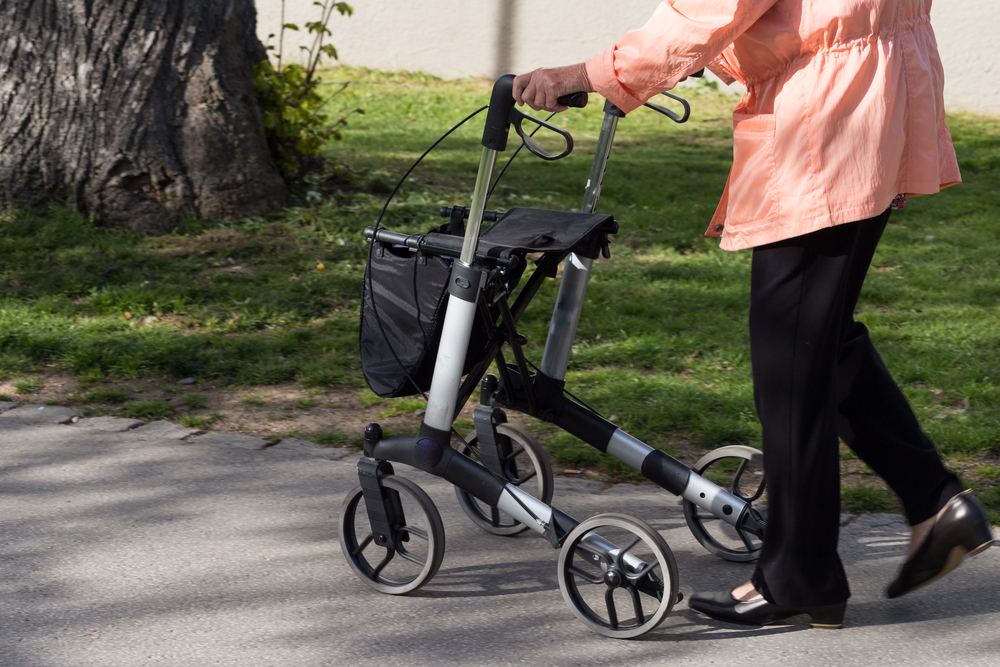Learning to Roll Through Life with Rollators


Did you know that walkers weren’t invented until the 1950s? I shudder to think how mobility-challenged people managed to get around, or didn’t, before that time. And it wasn’t until 1978, when a woman in Sweden (who had polio) added four wheels onto her walker, creating what is now known as a rollator.
Most of us who use rollators don’t really care about its history; we are just happy they exist and that they help us walk with balance and confidence. But, in the beginning, I’ll admit I wasn’t happy at all about having to use one.
Oh, I had many friends who used a walker following their knee or hip surgeries, but those aluminum-framed, hospital-issued devices were temporary, representing recovery and a return to normal active life.
For me, having ALS and being told I needed a rollator represented acknowledgement that I wasn’t in recovery. My condition was permanent and for me, a new normal.
At first I noticed all the negatives. For instance, it was intrusive; it was (I believed) the first thing people noticed when I entered a room. It showed up in photographs, and when hugging a friend my rollator became a third party in the entanglement.
But when out and about I learned my rollator was actually a helpful visual “alert” to others not to bump into me. It also acted as a safety barrier, saving me from wayward children running past.
Multiple uses
I soon discovered several alternate uses. For example, at the bathroom sink, I swing my rollator directly behind me and lock the brakes. This transforms it into an emergency landing pad I should happen to teeter backward.
Besides helping me walk, it has become part of my daily exercise routine. I stand directly in front of a sturdy chair with my rollator parked in front of me , with its wheels locked in place. I can perform any number of simple calisthenic movements, knowing that if I should lose balance the chair is behind me and my rollator is an easy grab in front.
It’s even become my ever-present silent buddy. Whether I’m at the computer, eating a meal, or by my bedside at night, it’s never more than an arm’s length away. I’ll even feel twinges of separation anxiety whenever restaurant staff stow it in a far-off corner away from my line of sight. I imagine the scenario of it being stolen and having to either crawl out of the place on my hands and knees or, be hoisted overhead and carried out like the Queen of Sheba!
OK, OK, if we’re being honest here, I’ll fully confess that after living with a rollator for the past six years, I now cannot imagine my life without one. In fact, I’m the proud owner of three. One is designated for indoor use only, another sits on the back porch, and the third is stowed in our van for use on-the-go. The whole set-up makes for seamless travel from one end of the house to the other — my own “pony express of rollators!”
But I haven’t found the ideal rollator, yet.
Knowing that rollators were invented nearly 40 years ago and the few design modifications made since then were mainly for the elderly market, I think it’s time for a system-wide update. How about a “Smart Rollator?” Here are a few suggestions I think should be included:
- Wi-fi accessibility. A simple push of a button on the handle would turn answering a cell phone while walking into an easy maneuver.
- Rather than squeezing the hand brakes, let the brakes be controlled by an on-off button accessed via the handles. Plus add a dial for easy braking down an incline.
- Offer more color choices beyond black, red and white (or the gratuitous pink).
- The existence of hoverboards, Segways and classy compact luggage shows me that someone could design a stylish rollator.
Looking back, I realize that the evolution of my mindset from initially disliking rollators to now thinking of ways to improve them, has come a long way. It’s all part of learning to “live well while living with ALS.”
***
Note: ALS News Today is strictly a news and information website about the disease. It does not provide medical advice, diagnosis, or treatment. This content is not intended to be a substitute for professional medical advice, diagnosis, or treatment. Always seek the advice of your physician or other qualified health provider with any questions you may have regarding a medical condition. Never disregard professional medical advice or delay in seeking it because of something you have read on this website. The opinions expressed in this column are not those of ALS News Today, or its parent company, Bionews Services, and are intended to spark discussion about issues pertaining to ALS.







Charlie
They got around in wheelchairs before the 50s.
julie
Had to flip back to this older blog because I'm curious if there's any research as to the use of a cane vs. rollator for people with balance issues. Rollator seems to offer more stability and evenness of travel. Any thoughts?
Dagmar Munn
Interesting question Julie - - I think that since there are so many variations of balance issues and variations in causes, it is hard to fit a one-size-fits-all solution to them. Rather than seeing cane vs. rollator as an either/or situation, I view rollators as a welcome transition. Rollators have only been around since the 1950s, prior to that, persons not able to use a cane anymore had to go directly to a wheelchair. Now, rollators offer an extended period of physical mobility for those of us who depend on them.
Christina
I want to order a rollator for a dear friend with ALS. I'm still unsure of all the limitations of her condition, but I hope to purchase one that will be useful for a longer period of time (if her condition continues to steadily worsen). You mentioned owning three-any recommendations? I'm hoping to order one that could work both indoors and outdoors.
Can you advise me? Many thanks!
Dagmar Munn
What a thoughtful gift for your friend!
My three rollators represent my own evolution in learning the good/bad points of rollators. All rollators fold up and are made for both indoor as well as outdoor use. Price varies drastically - - and is dependent on quality and specific features. My first purchase was an $89 (considered cheap) one from the drugstore. It has small wheels, has no feeling of sturdiness and the hand-brakes are not reliable. Now, my go-to/favorite is a Drive "Nitro" (around $189-200 also available on Amazon). Large 10" wheels, lightweight yet feels sturdy, its base is wider so no fear of tipping and it goes over door frames, gravel, bumps in the road with ease. How about taking your friend to a store that sells a variety of brands and let her try them and point out which features work best for her? Good luck and hugs to your lucky friend!
Christina
I so appreciate you taking the time to answer! (I wish I could send you a real thank you note!) I wanted to let you know that I just placed my order for the Drive Nitro and I can't wait to present it to my friend. Many thanks for helping steer me in the right direction:-)
Wishing you all the best!
Dagmar Munn
You are most welcome :-)
Cicilia
Hi Ms! I am currently doing an assignment regarding rollator walkers, and how existing rollator walkers can be improved. I noticed that you have put suggestions for a smart rollator but I was wondering if you have any other suggestions that you could think of. Your answer will be a very valuable feedback for my team to work on improving existing rollator walkers, and what other features a rollator walker should offer to improve the consumer's experience. Thanks! :)
Louise A Cort
When I came to the point of purchasing a rollator earlier this year, a friend recommended the upright rollator (brand Upwalker) he was using. I bought one and have been delighted. Its construction allows me to rest my forearms on adjustable supports and walk upright, not hunched forward. It has a comfortable seat (can be rolled right up to the dinner table) and bars to assist in standing up from the seat.
Dagmar Munn
Sounds like you have a winner, Louise. And so good to find one that works for you on the first try. Best, Dagmar